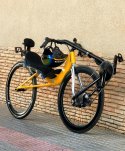I ride JCOB carbon cranks, 160mm. They have a more affordable aluminum crank in 150/155 length. These use the Shimano 24mm spindle, which will fit the appropriate T47 bb just fine. Here's the link:
https://speedandcomfort.com/collections/short-cranksets
I have these low cost 155mm cranks on my V20:
https://www.ebay.com/itm/194306075275 Not sure if they will fit the new V20C.
Thanks for the links. I already knew about the JCOB cranks, but not about that BBK version from ebay. Also, the JCOB carbon crank doesn't seem to available in sizes shorter than 165mm anymore. Both of these would work on the new V20c, but both are compact cranks. The JCOB cranks seem to have fixed chainrings at 34/50, and the BBK one has mounting holes with a 110mm Bold Circle Diameter, so the smallest chainring there would be 33t.
Which means to get mountain gearing with those, I would need a larger cassette and heavier rear derailleur. With my current setup, I use a small front chainring (26t) with an SRAM Red 22 rear derailleur (163g) with a light 11-32 cassette (196g), for a total of 359g. For equivalent gearing ratios on a compact crank, I could use, for example: SRAM Eagle XX1 RD at 270g with SRAM XX1 cassette 11-42 at 263g for a total of 533g.
So all other things being equal, changing my gearing system would incur a weight penalty of at least 174g, which would reduce the weight advantage of the V20c from 370g to less than 200g.
Going all 1x would lose the front derailleur (74g), but make the cassette even heavier (375g for 10-52 vs 196g for 11-32). However, there are a lot of other factors coming in with 1x, like smaller front chainring, less cables, possibly lighter braker lever etc, so the total weight for 1x might be less, even against my custom setup, but only barely so.
The oversized front quick release of the old V20 weighs 59g. I wonder if the equivalent oversized thru axle will be much heavier (or lighter?) than that. I suspect it will be heavier. And in both cases, it is hard to find aftermarket lightweight parts because of the non-standard length.
In any case, counting grams is a fun exercise for those so inclined, but in practice, with equivalent components, both the old and the new V20 will probably be so close to each other in terms of weight that the difference will barely matter (at least with components that meet my personal requirements).



